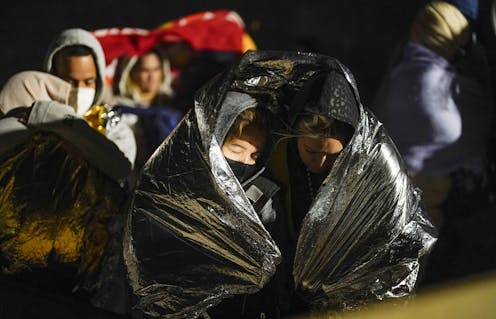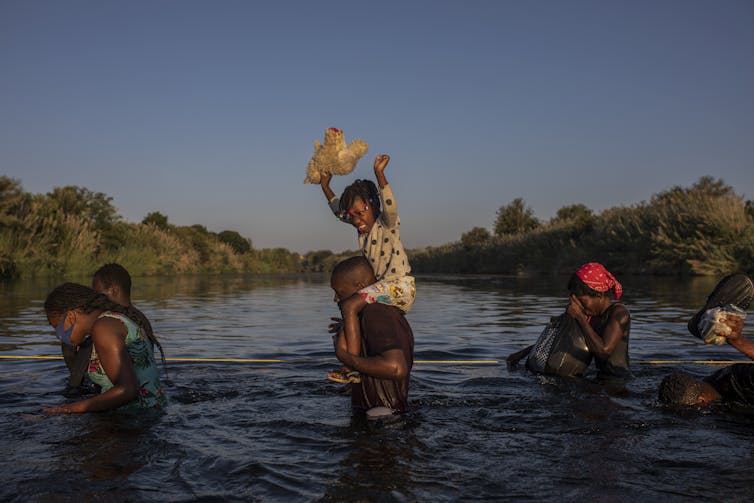Biden's border crackdown explained – a refugee law expert looks at the legality and impact of new as
With the expiration of a pandemic-era restriction, the Biden administration is set to impose a new rule to curtail immigration at the US-Mexico border.

Anticipating a potential surge of migrants at the southern border, the Biden administration on Feb. 21, 2023, announced a crackdown on those seeking asylum after unlawfully entering the U.S.
The proposed rule change – which would see the rapid deportation of anyone who had not first applied for asylum en route to the U.S. – has been condemned by immigration rights groups, which claim it runs counter to the “humane immigration system” that Joe Biden promised while campaigning for the White House.
The Conversation asked Karen Musalo, an expert on refugee law at the University of California College of the Law, San Francisco, to explain what the new rule entails, what its impact will be and why it is so controversial.
What is the new policy?
The Biden administration’s new rule – which is set to come into force on May 11 – will bar from asylum all non-Mexican migrants who arrive at the southern U.S. border without having first sought and been denied asylum in at least one of the countries they passed through on their journey.
The only migrants exempted from this rule are those who use a U.S. government app, CBP One, to make an appointment to apply for asylum at an official port of entry. All others will be subject to a presumption of ineligibility unless they can demonstrate “exceptionally compelling circumstances,” such as a medical emergency – which they will have to prove during a rapid screening process in a border holding cell.
The policy – which immigrant rights advocates, congressional leaders and faith groups are calling an “asylum ban” or “transit ban” – is almost identical to one implemented by the Trump administration in 2019. The Trump-era rule was later struck down by the courts as unlawful.
Why is the new rule being proposed now?
The Biden administration is concerned that the expiration of a pandemic-era rule will lead to greater numbers of immigrants at the southern border.
In March 2020, the Trump administration totally closed the border to asylum seekers in a policy referred to as Title 42. It justified the closure as necessary to protect public health during the COVID-19 pandemic. However, these health concerns were just a pretext; it has been well documented that high-level officials in the Centers for Disease Control and Prevention were opposed to the policy and acceded only under intense White House pressure.
Turning away all asylum seekers in this way was totally unprecedented, and inconsistent with U.S. domestic and international legal obligations.
Biden campaigned on promises to restore a humane asylum system. But on assuming the presidency he continued Title 42 and even expanded it to include individuals from additional countries.
Immigration rights advocates brought successful legal challenges to terminate the policy, while attorneys general of Republican-led states sued to keep it in place. Finally, in January 2023, the Biden administration announced that on May 11 it would end the coronavirus health emergency, which had provided the legal authority for the border closure.
This means Title 42 also comes to an end on May 11. Unwilling to restore access to asylum as had existed for 40 years before former President Donald Trump’s border closure, the Biden administration proposed the new rule.
Is the policy legal?
In 2019, the Trump administration proposed a rule very similar to that put forth by Biden, prohibiting asylum for migrants who did not first apply in countries of transit. The courts struck down the policy for violating the 1980 Refugee Act, which guarantees the right of all migrants who reach the United States to apply for asylum.
A bipartisan Congress passed the Refugee Act to bring the U.S. into compliance with its international obligations under the U.N.‘s 1951 Refugee Convention and its 1967 Protocol, which prohibit returning refugees to any country where their lives or freedom would be threatened.
In striking down the Trump-era rule, the 9th U.S. Circuit Court of Appeals pointed out that the Refugee Act is very specific about the circumstances under which the government can deny asylum for failure to apply in a transit country. Under the act’s “safe third country” provision, that can happen only if the transit country is safe and has both a robust asylum system and a formal treaty with the United States agreeing to safe third-country status. The court found the Trump administration lacked all three conditions for imposing such a ban.
The Biden rule is somewhat different from Trump’s. It does not apply to individuals who schedule an asylum appointment at ports of entry through the CBP One app.
But this does not make the policy lawful. The Refugee Act expressly permits asylum seekers to access protection anywhere along the border – not just at ports of entry. And it does not require appointments to be made in advance.
In addition, CBP One has been plagued with significant technical problems, preventing many from even making appointments, and has raised serious equity and privacy concerns.
And more importantly, there is no getting around the fact that most countries of transit neither are safe for migrants nor have functioning asylum systems.

Asylum seekers arriving at the U.S. southern border pass through Mexico, which is notoriously dangerous for migrants, and countries such as Nicaragua, El Salvador, Guatemala and Honduras, which are similarly unsafe and do not have anything approaching functioning asylum systems.
Costa Rica, the one transit country in the region with an admirable human rights record and an established asylum system, is currently receiving 10 times the number of asylum seekers as the United States on a per capita basis, and its system is completely overwhelmed. To expect Costa Rica to do more, and take in the refugees the U.S. turns away, is not reasonable or fair.
What will be the policy’s impact?
This rule will deny thousands of migrants fleeing persecution their right to seek asylum at the United States’ southern border. They will be returned to Mexico, where human rights organizations have documented high levels of violence and exploitation of migrants, or deported to their home countries.
Beyond the individual human impact, the implementation of this rule will send the wrong signal to other countries that have – like the United States – ratified international refugee treaties and passed laws committing to protect those fleeing persecution.
The message is that flouting legal obligations is acceptable, as is the outsourcing of refugee protection to smaller countries with far less resources. The exodus of refugees from Ukraine and U.S. efforts to encourage European countries to accept those fleeing the conflict underscore the importance of encouraging nations to take in refugees. Leading by bad example will only undermine that principle.
Karen Musalo receives funding from National Science Foundation in the past. I am a full-time law professor and director of the law school's Center for Gender & Refugee Studies.
Read These Next
LA fires showed how much neighborliness matters for wildfire safety – schools can do much more to te
Managing fire risk is about more than regulations and rules. It’s also about caring for neighbors…
Who thinks Republicans will suffer in the 2026 midterms? Republican members of Congress
The president’s party almost always loses seats in the midterms. More than two dozen Republican House…
New materials, old physics – the science behind how your winter jacket keeps you warm
Winter jackets may seem simple, but sophisticated engineering allows them to keep body heat locked in,…






